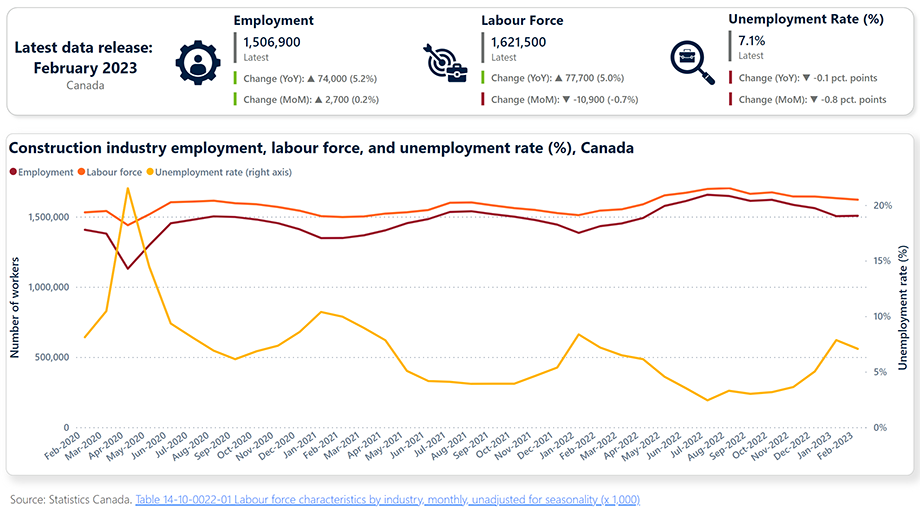Data from Statistics Canada’s Labour Force Survey (LFS) for February shows that employment for all industries increased slightly (+22,000 workers; +0.1%) for the month.
February marked a third consecutive increase in overall national employment, and is part of a broader series of increases that began in September 2022. Employment has added 348,000 workers (+1.8%) between August 2022 and February 2023.
The employment rate – the percentage of people aged 15 and older who are employed – was 62.4% in the month, down 0.1 percentage points from the recent high observed in January. The rate in January was the highest since May 2019 (62.5%).
The unemployment rate held steady at 5% in February, just shy of the record-low 4.9% observed in June and July of 2022.
LFS estimates for February are for the week of February 12 to 18, 2023.
Construction employment metrics remain above 2022 levels
At the national level, construction employment added 2,600 workers (+0.2%) in February, reaching above 1.5 million workers. Compared to February 2022, sector employment was up by 74,100 workers (+5.2%).
Although the labour force contracted by 10,900 workers (-0.7%) in February, it remains 77,800 workers (+5%) above February 2022 levels. The total number of people in the construction labour force was 1.6 million in February 2023. These factors left the industry’s national unemployment rate unchanged at 7.1%, and down slightly from the 7.2% reported in February 2022.

On a month-over-month basis, five provinces recorded employment growth in February, with Quebec recording the greatest increase at 3.6%. Prince Edward Island also recorded a notable increase of 3.3%. New Brunswick, Ontario, and Manitoba reported gains of 0.4% or less. Conversely, Newfoundland and Labrador reported the greatest employment contraction (-4.7%) for the month, with Nova Scotia also reporting a loss of more than 4%.
Compared to the same time last year, most provinces continued to show signs of growth. The greatest year-over-year employment changes were seen in Newfoundland and Labrador (+13.4%), British Columbia (+13%), and Quebec (+10.6%). New Brunswick and Manitoba also reported annual increases of more than 9%. Only Saskatchewan (-7.1%), Prince Edward Island (-4.5%), and Alberta (-2.2%) reported employment contractions compared with a year previous.
Labour force data followed similar trends, with Newfoundland and Labrador (-6.3%), Alberta (-2.7%), and New Brunswick (-2.3%) reporting the largest contractions for the month, and Prince Edward Island (+4.1%) reporting the greatest gains. Year over year, the largest labour force increases were seen in British Columbia (+13.4%), Quebec (+10.5%), and Manitoba (+7.5%), while the greatest contractions were reported in Saskatchewan (-10.5%), Prince Edward Island (-3.8%), and Alberta (-1.9%). All other provinces reported gains of between 3.1% and 6.7%.
Across the provinces, construction unemployment rates were highest in Atlantic Canada, with Newfoundland and Labrador reporting a high rate of 27.8%, and Nova Scotia reporting a regional low of 13.7%. Elsewhere, rates varied between a high of 8.3% in Alberta and a low of 4.7% in British Columbia.


Construction Key Indicators
